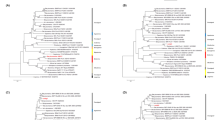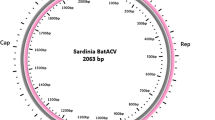Abstract
Circular replication-associated protein encoding single-stranded DNA (CRESS DNA) viruses are increasingly recognized worldwide in a variety of samples. Representative members include well-described veterinary pathogens with worldwide distribution, such as porcine circoviruses or beak and feather disease virus. In addition, numerous novel viruses belonging to the family Circoviridae with unverified pathogenic roles have been discovered in different human samples. Viruses of the family Genomoviridae have also been described as being highly abundant in different faecal and environmental samples, with case reports showing them to be suspected pathogens in human infections. In order to investigate the genetic diversity of these viruses in European bat populations, we tested guano samples from Georgia, Hungary, Romania, Serbia and Ukraine. This resulted in the detection of six novel members of the family Circoviridae and two novel members of the family Genomoviridae. Interestingly, a gemini-like virus, namely niminivirus, which was originally found in raw sewage samples in Nigeria, was also detected in our samples. We analyzed the nucleotide composition of members of the family Circoviridae to determine the possible host origins of these viruses. This study provides the first dataset on CRESS DNA viruses of European bats, and members of several novel viral species were discovered.

Similar content being viewed by others
References
Kohl C, Kurth A (2014) European bats as carriers of viruses with zoonotic potential. Viruses 6:3110–3128. https://doi.org/10.3390/v6083110
Kemenesi G, Dallos B, Görföl T, Boldogh S, Estók P, Kurucz K, Kutas A, Földes F, Oldal M, Németh V, Martella V, Bányai K, Jakab F (2014) Molecular survey of RNA viruses in Hungarian bats: discovering novel astroviruses, coronaviruses, and caliciviruses. Vector Borne Zoonotic Dis 14:846–855. https://doi.org/10.1089/vbz.2014.1637
Vidovszky M, Kohl C, Boldogh S, Görföl T, Wibbelt G, Kurth A, Harrach B (2015) Random sampling of the Central European bat fauna reveals the existence of numerous hitherto unknown adenoviruses. Acta Vet Hung 63:508–525. https://doi.org/10.1556/004.2015.047
Dufkova L, Straková P, Širmarová J, Salát J, Moutelíková R, Chrudimský T, Bartonička T, Nowotny N, Růžek D (2015) Detection of diverse novel bat astrovirus sequences in the Czech Republic. Vector Borne Zoonotic Dis 15:518–521. https://doi.org/10.1089/vbz.2015.1813
Li L, Victoria JG, Wang C, Jones M, Fellers GM, Kunz TH, Delwart E (2010) Bat guano virome: predominance of dietary viruses from insects and plants plus novel mammalian viruses. J Virol 84:6955–6965. https://doi.org/10.1128/JVI.00501-10
Kemenesi G, Földes F, Zana B, Kurucz K, Estók P, Boldogh S, Görföl T, Bányai K, Oldal M, Jakab F (2016) Genetic characterization of Providence virus isolated from bat guano in Hungary. Genome Announc 4:e00403-16. https://doi.org/10.1128/genomeA.00403-16
Reuter G, Pankovics P, Gyöngyi Z, Delwart E, Boros A (2014) Novel dicistrovirus from bat guano. Arch Virol 159:3453–3456. https://doi.org/10.1007/s00705-014-2212-2
Wu Z, Yang L, Ren X, He G, Zhang J, Yang J, Qian Z, Dong J, Sun L, Zhu Y, Du J, Yang F, Zhang S, Jin Q (2016) Deciphering the bat virome catalog to better understand the ecological diversity of bat viruses and the bat origin of emerging infectious diseases. ISME J 10:609–620. https://doi.org/10.1038/ismej.2015.138
Lima FE, Cibulski SP, Dos Santos HF, Teixeira TF, Varela AP, Roehe PM, Delwart E, Franco AC (2015) Genomic characterization of novel circular ssDNA viruses from insectivorous bats in Southern Brazil. PLoS One 10:e0118070. https://doi.org/10.1371/journal.pone.0118070
Lima FE, Cibulski SP, Dall Bello AG, Mayer FQ, Witt AA, Roehe PM, d’Azevedo PA (2015) A novel chiropteran circovirus genome recovered from a Brazilian insectivorous bat species. Genome Announc 3:e01393-15. https://doi.org/10.1128/genomeA.01393-15
Ge X, Li J, Peng C, Wu L, Yang X, Wu Y, Zhang Y, Shi Z (2011) Genetic diversity of novel circular ssDNA viruses in bats in China. J Gen Virol 92:2646–2653
Li L, Shan T, Soji OB, Alam MM, Kunz TH, Zaidi SZ, Delwart E (2011) Possible cross-species transmission of circoviruses and cycloviruses among farm animals. J Gen Virol 92:768–772. https://doi.org/10.1099/vir.0.028704-0
Male MF, Kraberger S, Stainton D, Kami V, Varsani A (2016) Cycloviruses, gemycircularviruses and other novel replication-associatedprotein encoding circular viruses in Pacific flying fox (Pteropus tonganus) faeces. Infect Genet Evol 39:279–292. https://doi.org/10.1016/j.meegid.2016.02.009
Rosario K, Duffy S, Breitbart M (2012) A field guide to eukaryotic circular single-stranded DNA viruses: insights gained from metagenomics. Arch Virol 157:1851–1871
Nash TE, Dallas MB, Reyes MI, Buhrman GK, Ascencio-Ibañez JT, Hanley-Bowdoin L (2011) Functional analysis of a novel motif conserved across geminivirus Rep proteins. J Virol 85:1182–1192. https://doi.org/10.1128/JVI.02143-10
Rosario K, Breitbart M, Harrach B, Segalés J, Delwart E, Biagini P, Varsani A (2017) Revisiting the taxonomy of the family Circoviridae: establisment of the genus Cyclovirus and removal of the genus Gyrovirus. Arch Virol 162:1447–1463
Garigliany MM, Börstler J, Jöst H, Badusche M, Desmecht D, Schmidt-Chanasit J, Cadar D (2015) Characterization of a novel circo-like virus in Aedes vexans mosquitoes from Germany: evidence for a new genus within the family Circoviridae. J Gen Virol 96:915–920. https://doi.org/10.1099/vir.0.000036
Varsani A, Krupovic A (2017) Sequence-based taxonomic framework for the classification of uncultured single-stranded DNA viruses of the family Genomoviridae. Virus Evolution 3:vew037
Krupovic M, Ghabrial SA, Jiang D, Varsani A (2016) Genomoviridae: a new family of widespread single-stranded DNA viruses. Arch Virol 161:2633–2643. https://doi.org/10.1007/s00705-016-2943-3
Kunz TH, Hodgkison R, Weise CD (2009) Methods of capturing and handling bats. In: Kunz T, Parsons S (eds) Ecological and behavioral methods for the study of bats, 2nd edn. Johns Hopkins University Press, Baltimore, pp 3–35
Kemenesi G, Dallos B, Görföl T, Estók P, Boldogh S, Kurucz K, Oldal M, Marton S, Bányai K, Jakab F (2015) Genetic diversity and recombination within bufaviruses: detection of a novel strain in Hungarian bats. Infect Genet Evol 33:288–292. https://doi.org/10.1016/j.meegid.2015.05.017
Kemenesi G, Zhang D, Marton S, Dallos B, Görföl T, Estók P, Boldogh S, Kurucz K, Oldal M, Kutas A, Bányai K, Jakab F (2015) Genetic characterization of a novel picornavirus detected in Miniopterus schreibersii bats. J Gen Virol 96:815–821. https://doi.org/10.1099/jgv.0.000028
Bányai K, Kemenesi G, Budinski I, Földes F, Zana B, Marton S, Varga-Kugler R, Oldal M, Kurucz K, Jakab F (2017) Candidate new rotavirus species in Schreiber’s bats, Serbia. Infect Genet Evol 48:19–26. https://doi.org/10.1016/j.meegid.2016.12.002
Buchfink B, Xie C, Huson DH (2015) Fast and sensitive protein alignment using DIAMOND. Nat Methods 12:59–60
Huson DH, Beier S, Flade I, Górska A, El-Hadidi M, Mitra S, Ruscheweyh HJ, Tappu R (2016) MEGAN community edition—interactive exploration and analysis of large-scale microbiome sequencing data. PLoS Comput Biol 12:e1004957
Li L, Kapoor A, Slikas B, Bamidele OS, Wang CL, Shaukat S, Masroor MA, Wilson ML, Ndjango JBN, Peeters M, Gross-Camp ND, Muller MN, Hahn BH, Wolfe ND, Triki H, Bartkus J, Zaidi SZ, Delwart E (2010) Multiple Diverse Circoviruses infect farm animals and are commonly found in human and chimpanzee feces. J Virol 84:1674–1682. https://doi.org/10.1128/JVI.02109-09
Kearse M, Moir R, Wilson A, Stones-Havas S, Cheung M, Sturrock S, Buxton S, Cooper A, Markowitz S, Duran C, Thierer T, Ashton B, Mentjies P, Drummond A (2012) Geneious Basic: an integrated and extendable desktop software platform for the organization and analysis of sequence data. Bioinformatics 28:1647–1649
Muhire BM, Varsani A, Martin DP (2014) SDT: a virus classification tool based on pairwise sequence alignment and identity calculation. PLoS One 9:e108277. https://doi.org/10.1371/journal.pone.0108277
Guindon S, Dufayard JF, Lefort V, Anisimova M, Hordijk W, Gascuel O (2010) New algorithms and methods to estimate maximum-likelihood phylogenies: assessing the performance of PhyML 3.0. Syst Biol 59:307–321
Charif D, Lobry JR (2007) SeqinR 1.0-2: a contributed package to the R project for statistical computing devoted to biological sequences retrieval and analysis. Structural approaches to sequence evolution: molecules, networks, populations. http://cran.R-project.org/package=seqinr. Accessed 30 June 2016
R Development Core Team (2015) R: A language and environment for statistical computing. R Foundation for Statistical Computing, Vienna, Austria. http://www.R-project.org. Accessed 30 June 2016
IBM Corp. Released (2016) IBM SPSS statistics for windows, Version 24.0. Armonk, NY, IBM Corp
Kraberger S, Argüello-Astorga GR, Greenfield LG, Galilee C, Law D, Martin DP, Varsani A (2015) Characterisation of a diverse range of circular replication-associated protein encoding DNA viruses recovered from a sewage treatment oxidation pond. Infect Genet Evol 31:73–86
Ng TF, Marine R, Wang C, Simmonds P, Kapusinszky B, Bodhidatta L, Oderinde BS, Wommack KE, Delwart E (2012) High variety of known and new RNA and DNA viruses of diverse origins in untreated sewage. J Virol 86:12161–12175. https://doi.org/10.1128/JVI.00869-12
Zhang T, Breitbart M, Lee WH, Run JQ, Wei CL, Soh SW, Hibberd ML, Liu ET, Rohwer F, Ruan Y (2006) RNA viral community in human feces: prevalence of plant pathogenic viruses. PLoS Biol 4:108–118
Sikorski A, Massaro M, Kraberger S, Young LM, Smalley D, Martin DP, Varsani A (2013) Novel myco-like DNA viruses discovered in the faecal matter of various animals. Virus Res 177:209–216. https://doi.org/10.1016/j.virusres.2013.08.008
Rosario K, Dayaram A, Marinov M, Ware J, Kraberger S, Stainton D, Breitbart M, Varsani A (2012) Diverse circular single-stranded DNA viruses discovered in dragonflies (Odonata: Epiprocta). J Gen Virol 92:1302–1308. https://doi.org/10.1099/vir.0.045948-0
Lukashev AN, Corman VM, Schacht D, Gloza-Rausch F, Seebens-Hoyer A, Gmyl AP, Drosten C, Drexler JF (2017) Close genetic relatedness of picornaviruses from European and Asian bats. J Gen Virol 98:955–961. https://doi.org/10.1099/jgv.0.000760 (Epub 2017 May 30)
Sato G, Kawashima T, Kiuchi M, Tohya Y (2015) Novel cyclovirus detected in the intestinal contents of Taiwan squirrels (Callosciurus erythraeus thaiwanensis). Virus Genes 51:148–151. https://doi.org/10.1007/s11262-015-1217-6
Tamura N, Hayashi F, Miyashita K (1989) Spacing and kinship in the Formosan squirrel living in different habitats. Oecologia 79:344–352. https://doi.org/10.1007/BF00384313
le Tan V, van Doorn HR, Nghia HD, Chau TT, le Tu TP, de Vries M, Canuti M, Deijs M, Jebbink MF, Baker S, Bryant JE, Tham NT, Krong NT, Boni MF, Loi TQ, le Phuong T, Verhoeven JT, Crusat M, Jeeninga RE, Schultsz C, Chau NV, Hien TT, van der Hoek L, Farrar J, de Jong MD (2013) Identification of a new cyclovirus in cerebrospinal fluid of patients with acute central nervous system infections. MBio 4:e00231-13. https://doi.org/10.1128/mBio.00231-13
Zhou C, Zhang S, Gong Q, Hao A (2015) A novel gemycircularvirus in an unexplained case of child encephalitis. Virol J 12:197. https://doi.org/10.1186/s12985-015-0431-0
Acknowledgements
We gratefully thank Olena Rodenko and Vitalii Hukov from the Bat Rehabilitation Center of Feldman Ecopark, Ukraine, for their help in bat sampling. Research activities in Serbia were supported by the Ministry of Education, Science and Technological Development of Serbia, Grant No. 173003. The research activity of F.J. was supported by TÁMOP (4.2.4.A/2-11-1-2012-0001)—National Excellence Program. K.K. was supported by the Szentágothai Talent Program (awarded by the Szentágothai Research Centre, University of Pécs). G.K. and F.J. were supported by the ÚNKP-17-3-III and ÚNKP-17-4-III—New National Excellence Program of the Ministry of Human Capacities. The project was supported by the European Union, co-financed by the European Social Fund: Comprehensive Development for Implementing Smart Specialization Strategies at the University of Pécs (EFOP-3.6.1.-16-2016-00004), and by the University of Pécs in the framework of the “Viral Pathogenesis” Talent Centre program. The present scientific contribution is dedicated to the 650th anniversary of the foundation of the University of Pécs, Hungary.
Author information
Authors and Affiliations
Corresponding author
Ethics declarations
Ethical approval
All applicable international, national, and/or institutional guidelines for the care and use of animals were followed.
Conflict of interest
The authors declare no conflict of interest.
Additional information
Handling Editor: Roman Pogranichniy.
Electronic supplementary material
Below is the link to the electronic supplementary material.
Rights and permissions
About this article
Cite this article
Kemenesi, G., Kurucz, K., Zana, B. et al. Diverse replication-associated protein encoding circular DNA viruses in guano samples of Central-Eastern European bats. Arch Virol 163, 671–678 (2018). https://doi.org/10.1007/s00705-017-3678-5
Received:
Accepted:
Published:
Issue Date:
DOI: https://doi.org/10.1007/s00705-017-3678-5




